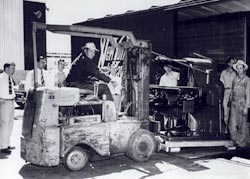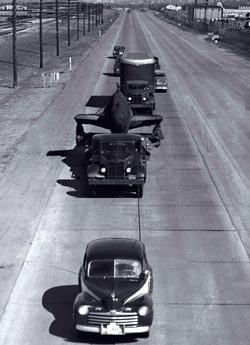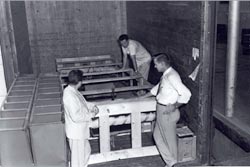|
|
Thirty Million Pounds On Wheels
There was no railroad siding at the Stratford plant. The railroad station stood 1.6 miles away. The situation called for a lot of teamwork between the traffic, maintenance and shipping sections, and the work of moving giant machines was so new to all of them that many lessons had to be learned. The traffic section hired three additional drivers and rented trucks to transport material from the plant to the Stratford station. The shipping section, too, was short-handed. Eighty-five new persons, some drawn from units which had discontinued operations, joined the shipping section in May. Ed Brooks, the shipping foreman, asked a few of the new men: “Ever seen the inside of a freight car?” Their answer was always, “no”. Loading a freight car was no job for an amateur, and the first estimates showed that 1,200 of them were to be moved. So Graham Reid, the purchasing manager, got together with the American Railroad Association and had experts come into the plant and lecture the men loading the freight cars. These engineers instructed the Chance Vought men in skidding, boxing, and proper loading methods, and spent much of the first month of the move at the plant offering suggestions and advice.
 On 6 May 1948, two freight cars left Stratford railroad station to open the greatest industrial migration in history. They were loaded with a strange assortment of freight: heavy machinery, fans, furniture, stationary and medical equipment. They were, in a sense, guinea pigs. Shipping procedures had not yet been perfected, and these initial cars were to be carefully watched, so that better methods could be developed in loading the hundreds of cars yet to go. Chance Vought had had little experience in moving heavy equipment. Shipping of aircraft spares was virtually the extent of their experience. At first, the shipping and maintenance men thought they could get the material out by hand for the most part, but the job was too big. All available towmotors and lift trucks were corralled, and the company obtained war surplus towing machines in Dallas to bring to Stratford. Now mechanized, the shippers could speed up the movement of material from the receiving dock to the trucks and from the trucks to the freight cars. Originally, the plan was to use a section of the shipping space as a warehouse, accumulating material to be shipped, sorting it into carloads, and dispatching it to trucks to go to the freight yards. When the first two cars left, they had been loaded laboriously under this system. “You’ll be lucky if you can get 15 cars a week of this stuff out,” one observer remarked to the shipping supervisor, looking at the mass of material, from pencil sharpeners to gigantic presses, being accumulated in the makeshift warehouse. The shippers reworked their plans. With the material coming in each day in such great volume, and of such unpredictable and diversified nature, the original “warehouse” system made for duplicate handling. “Why waste time with storage here?” the shippers reasoned. “Why not speed things up by using freight cars as warehouses. Just take everything directly to the freight yards, have ten or twelve cars on the tracks at all times, arrange the material in various cars, according to its urgency, and then when a freight car gets full, off it goes to Dallas. On 6 May 1948, two freight cars left Stratford railroad station to open the greatest industrial migration in history. They were loaded with a strange assortment of freight: heavy machinery, fans, furniture, stationary and medical equipment. They were, in a sense, guinea pigs. Shipping procedures had not yet been perfected, and these initial cars were to be carefully watched, so that better methods could be developed in loading the hundreds of cars yet to go. Chance Vought had had little experience in moving heavy equipment. Shipping of aircraft spares was virtually the extent of their experience. At first, the shipping and maintenance men thought they could get the material out by hand for the most part, but the job was too big. All available towmotors and lift trucks were corralled, and the company obtained war surplus towing machines in Dallas to bring to Stratford. Now mechanized, the shippers could speed up the movement of material from the receiving dock to the trucks and from the trucks to the freight cars. Originally, the plan was to use a section of the shipping space as a warehouse, accumulating material to be shipped, sorting it into carloads, and dispatching it to trucks to go to the freight yards. When the first two cars left, they had been loaded laboriously under this system. “You’ll be lucky if you can get 15 cars a week of this stuff out,” one observer remarked to the shipping supervisor, looking at the mass of material, from pencil sharpeners to gigantic presses, being accumulated in the makeshift warehouse. The shippers reworked their plans. With the material coming in each day in such great volume, and of such unpredictable and diversified nature, the original “warehouse” system made for duplicate handling. “Why waste time with storage here?” the shippers reasoned. “Why not speed things up by using freight cars as warehouses. Just take everything directly to the freight yards, have ten or twelve cars on the tracks at all times, arrange the material in various cars, according to its urgency, and then when a freight car gets full, off it goes to Dallas.
By this time, Chance Vought, with its gigantic shipments, had virtually taken over the Stratford station. Foreman Brooks had installed his desk in the depot and Chance Vought had leased a shed for storage of timber used for bracing and cradling. Water coolers and a first aid station had been installed, and forty men regularly assigned to loading freight cars reported there for work. “Aren’t you going to have an awful lot of demurrage?” a sidewalk superintendent asked Ed Beatty, the traffic and transportation chief. “I don’t think there’s any danger of that,” Beatty laughed, contemplating the vast factory floor, a forest of machines, benches and tables to be moved. There were more than 2 million aircraft parts and tools, not counting nuts and bolts. There were more than 2,000 machines, 4,000 pieces of office furniture, and 3,000 benches, cabinets and storage shelves. And there was no demurrage. As Brooks stood between the two tracks, each with its five to six cars, he would direct the material from the never-ending stream of trucks coming from the plant into this car or that car, according to its nature. “This furniture’s marked ‘urgent’, and they’ve got a rush call for that machine, too,” he would say. “Put them in that ‘hot car’ there.” And the material would be placed in a car routed by the shortest possible way. At times, twelve trucks would come at once to the clearing between the two tracks where the railroad cars stood. The men, hard workers, and now well trained and experienced in loading a car rapidly and skillfully, with braces and cradles in place, would move swiftly from car to car, back to the wood house for more lumber; and a car an hour would be loaded. “Forty a week,” they grinned, when shipments were at their peak, remembering the baleful bystander Who’d said that they couldn’t load fifteen.
The first two cars shipped arrived at Dallas with some scratched furniture and other damage. After that, shipments were closely checked. Certain cars of material were inspected at various points en route as to the condition of their loads. The learning curve on loading showed a sharp upward climb. There were high claims on the first 20 cars; then they tapered off and virtually disappeared. One day, there came an urgent call from Dallas for two carloads of material. The shipping men, with eight cars to load that day, saw they’d have to labor into the night. As dusk began to fall, someone shouted: “Turn on the lights!” Then there was consternation in the railroad yards. “What light?” someone yelled, and indeed, the leisurely Stratford station was not equipped for night loading. Back to the factory went a truck. A generator and two flood lamps were brought in and Chance Vought made its own power. The two rush cars got off to Dallas that night.
Another time, when a record heat wave hit Connecticut and plants closed throughout the area, the men at the loading dock and freight yards, aware that they were four cars behind, worked through the heat and made up the deficit. Not only that but they set the highest weekly record of cars shipped to date. Hundreds of freight cars streamed into the Stratford station to be fed by the inexhaustible supply of material that shuttled over from the plant in Chance Vought’s trucks. Transformer cars, flat cars, gondola cars, 40 and 50-foot boxcars, came and went. Light and heavy cars rolled out. One car, filled with bulky assembly fixtures, weighed only 7,920 pounds. The separate items inside the cars ranged in weight from 45 tons to one ounce. It was not enough to get the cars out at Stratford. Activities there had to be coordinated with Dallas, so that adequate personnel and equipment were available to get it installed with a minimum of delay. A close check was kept, by means of charts, of the comparative quantity of equipment received and equipment installed at a given time.
Not all of the shipping was done by rail. Some urgent material and delicate instruments went by air. And there were blueprints and confidential material that went by Chance Vought’s trucks. Nor did all of the material go to Dallas. Constantly, there were spare parts to be shipped to all corners of the world, and there were motors to be trucked to Bridgeport for rewinding. Toward the end of the move, when the F6U-1 program was nearing completion in Stratford, the trucks were constantly busy hauling subassemblies, and even complete airplanes. The first truck in the caravan arrived in Dallas the first week in January 1949 with a center section wing and a front section fuselage and, thereafter, additional shipments arrived in Dallas at the rate of one plane a week.
While they were transporting these loads, drivers of the Chance Vought trucks were constantly studying road conditions, making notes of road widths, bridge heights, and other factors, in preparation for their biggest job – the trucking of three completed Pirates to Texas. Canvas-wrapped, without wing tips or tail surfaces; these airplanes, on flatbed trucks, were 24 feet wide, taking up two lanes of a highway, and were 48 feet long and 13 feet high. Special permits had to be obtained from each state through which the Pirate traveled, and each state and county provided police escorts for the valuable and bulky cargo. Frequently, a road had to be blocked off completely for a considerable distance during the passage of a Pirate, and the route took in much mountainous terrain over which driving was a feat, even without such a cumbersome load.  The Pirate traveled in a convoy with a car driving in advance to notify highway police of the next county of its approach and a truck filled with fuselage sections followed to guard the plane from the rear. At nights, police kept watch over the plane. The first trip from Stratford, during which a storm was encountered, and the plane was not allowed on the highways during Saturdays and Sundays, took 11 days. The plane left Stratford on February 10 and arrived in Dallas on February 21, 1949. Sometimes, subassemblies and detail parts were so urgently needed that they were dispatched by air. A leased C-46 flew frequently to Hensley Field with aircraft parts for Chance Vought, and the company Beechcraft plied back and forth regularly with similar loads. The Pirate traveled in a convoy with a car driving in advance to notify highway police of the next county of its approach and a truck filled with fuselage sections followed to guard the plane from the rear. At nights, police kept watch over the plane. The first trip from Stratford, during which a storm was encountered, and the plane was not allowed on the highways during Saturdays and Sundays, took 11 days. The plane left Stratford on February 10 and arrived in Dallas on February 21, 1949. Sometimes, subassemblies and detail parts were so urgently needed that they were dispatched by air. A leased C-46 flew frequently to Hensley Field with aircraft parts for Chance Vought, and the company Beechcraft plied back and forth regularly with similar loads.
There was little time, during the move to Texas, for paper work. Two simple forms were designed for all material shipped to Dallas. A shipping and receiving memorandum contained all of the information needed for grouping, loading, billing, tracing and spotting at Dallas as well as unloading and positioning of shipments on the plant floor. A daily report of shipments was teletyped from Stratford to Dallas each day, showing numbers, gross weight and routing. Three typists were sufficient to do the work for the entire equipment move. Arriving in Dallas, the shipments required a minimum of paperwork.
In crating, cradling, and bracing the material in cars, Chance Vought’s maintenance and shipping men used more than 2 million board feet of lumber. One employee spent eight hours a day cutting and stacking the lumber used in loading freight cars. Blocks and cradlings were designed and re-designed to effect the greatest economy in the use of lumber. Even employees’ dogs and cats and personal toolboxes were brought in to be crated. “I don’t think there’s anything made that hasn’t been shipped in this move,” one man remarked. Ultimately, more than thirty million pounds were shipped, which was considerably less than the original estimate of sixty million pounds, purposely made high. The first estimate of 1200 freight cars was revised downward to 900 cars. Through it all, as a result of careful planning, close record checks and good handling, nothing was lost except a thousand pounds of dies, removed from a freight car by a thief, who must have had something of a moving problem himself. Apprehended, he confessed that he had sold a $4,000 die to a junk dealer for $85.
As the move progressed, loading operations reached such efficiency that half the manpower used there could be dropped or diverted to other operations. Once the freight cars were loaded, they went over a variety of routes. A few went directly to Dallas while others might go through Canada, or far to the south. The task of routing confronting Chance Vought’s traffic section was probably unique in the history of railroading. Some of the material to be shipped was of great weight while other was light but bulky. A heavy die might be mixed in a car with light but space consuming assembly fixtures. Since railroads normally determine the cost of a car by the material in it, a lower rate generally is paid for a car with uniform contents and a premium for mixed contents. Chance Vought’s shipments, however, going as they did by departments, could not achieve any degree of uniformity. Anticipating this, before the move had started, Ed Beatty, with Harry Crook, traffic manager for United Aircraft Corporation, made application to several railroad groups, and obtained a favorable shipping rate for mixed carloads. All the railroads of the United States had to concur on the rates. The freight was routed over many railroads, and many cars went over circuitous routes. Urgent cars, however, went directly to Dallas and the average elapsed time en route for all cars was ten days.
 The Texas and Pacific and Missouri Pacific, on whose right-of-way the spur to the Dallas plant was located, and who, consequently, handled much of the freight, set up a clearing house, keeping track of the whereabouts of all cars, routed over every railroad. Added to the work of routing cars of transferred equipment, the traffic section had still its regular job of sending out aircraft spares, and of routing material going to vendors and subcontractors. Now, with vendors and subcontractors in both Texas and Connecticut, this work was increasingly complex. Material ordered for parts to be subcontracted often had to be divided between the two states and routed to different sections of the country. So, for a time, Chance Vought’s possessions were scattered over the greater part of the North American continent. The fact that they did not move in a uniform caravan on one route to Dallas makes even more marvelous the fact that everything arrived. Even when a carload of equipment was wrecked in Virginia, it was virtually unharmed. Re-packed speedily into another car, it made the trip almost without delay The Texas and Pacific and Missouri Pacific, on whose right-of-way the spur to the Dallas plant was located, and who, consequently, handled much of the freight, set up a clearing house, keeping track of the whereabouts of all cars, routed over every railroad. Added to the work of routing cars of transferred equipment, the traffic section had still its regular job of sending out aircraft spares, and of routing material going to vendors and subcontractors. Now, with vendors and subcontractors in both Texas and Connecticut, this work was increasingly complex. Material ordered for parts to be subcontracted often had to be divided between the two states and routed to different sections of the country. So, for a time, Chance Vought’s possessions were scattered over the greater part of the North American continent. The fact that they did not move in a uniform caravan on one route to Dallas makes even more marvelous the fact that everything arrived. Even when a carload of equipment was wrecked in Virginia, it was virtually unharmed. Re-packed speedily into another car, it made the trip almost without delay
|